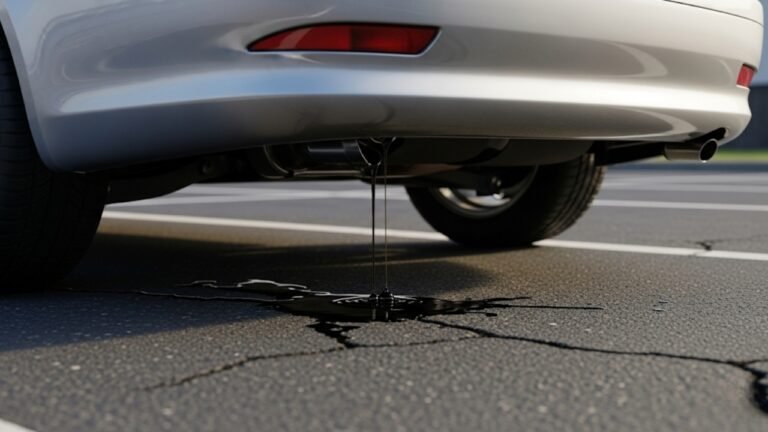How Many Miles for an Oil Change on a New Car?

There’s something magical about driving a new car for the first time. That fresh scent. The way the tires glide on the road. It’s a quiet joy, like the first sip of your morning coffee. But soon, a question creeps in — “How many miles for an oil change on a New Car?”
You’re not alone if you’re scratching your head. I remember when I bought my first car — a sleek blue sedan. I treated it like a newborn, checking every light, sound, and signal. And then, around 800 miles, I panicked: Should I change the oil now? Or wait? Or ask my friend who thinks he’s a car expert?
If you’re wondering the same, relax. This guide breaks everything down in plain, friendly terms. We’ll chat about oil changes, break-in periods, manufacturer tips, and what real drivers say. And yes — we’ll figure out the magic number of miles for an oil change on a new car together.
In This Article
- 1 Why Your New Car’s First Oil Change Matters More Than You Think
- 2 How Many Miles for an Oil Change on a New Car? A Real Answer
- 3 What the Manufacturers Really Say
- 4 Synthetic Oil vs. Conventional: Does It Change Things?
- 5 Driving Style Matters: Are You a Chill Driver or a Speed Demon?
- 6 Oil Life Monitors: Trust the Tech, But Use Your Gut Too
- 7 Signs Your New Car Might Need an Oil Change Sooner
- 8 Is There a Risk in Waiting Too Long? Short Answer: Yes
- 9 Quick Tips to Remember for New Car Oil Changes
- 10 Real Stories: What Drivers Say About Their First Oil Change
- 11 Conclusion: Take Care Early, Drive Happy Always
Why Your New Car’s First Oil Change Matters More Than You Think

In a new car, the engine is still adjusting. Parts are wearing in. Little metal shavings from the manufacturing process can float around the oil. That’s why your first oil change isn’t just a routine — it’s essential maintenance.
Think of it like breaking in new shoes. The first few walks shape them. Same goes for your engine. You want clean oil flowing after the first 500 to 1,500 miles. Most experts recommend not waiting past 2,000 miles for that first oil change, even if your car has synthetic oil or a “long-life” label.
Some manufacturers, like Toyota or Ford, design engines with tighter tolerances, so they might say you can wait till 5,000 miles. But guess what? Playing it safe in the beginning can pay off big time in the long run. My mechanic once told me: “Change it early, and your car will thank you later.”
So, don’t ignore this first milestone. It’s not just about ticking a box — it’s about building a solid foundation for your engine’s health.
How Many Miles for an Oil Change on a New Car? A Real Answer
Now, the golden question — how many miles for an oil change on a New Car? The answer depends on a few factors, but here’s a good rule of thumb:
| Car Type | Suggested First Oil Change |
| Economy Car | 1,000 – 1,500 miles |
| Sports Car | 500 – 1,000 miles |
| Luxury Car | 1,500 – 2,000 miles |
| Hybrid/Electric | Follow Manufacturer’s Manual |
| Trucks/SUVs | 1,000 – 2,000 miles |
For most new vehicles, the first oil change happens somewhere between 500 and 2,000 miles. That’s especially true if it’s your first 39 days of driving or the car has 39 miles already on it and you’re curious how soon that change should come.
Now, you might wonder: “But the manual says 7,500 miles!?” And sure, some modern engines with synthetic oil can go longer. But remember, engine break-in is a real thing. That first change is more about flushing out the gunk and ensuring your car gets a clean start.
It’s like cleaning your kitchen after cooking a big meal. Sure, the stove looks clean, but check underneath — there’s always grease hiding somewhere.
What the Manufacturers Really Say
Let’s be honest. We don’t always read the manual, right? I used to skip it too — until I spilled windshield washer fluid in the oil tank. Lesson learned.
But when it comes to how many miles for an oil change on a New Car, your manufacturer has a say. Brands like Honda, Hyundai, and Mazda recommend different things.
Here’s a quick look:
- Honda: Follow oil life monitor, but often suggests first oil change by 3,000 miles.
- Toyota: Recommends 5,000 miles, but early change is not discouraged.
- Hyundai: 1,500–2,000 miles is ideal for the first change.
- Ford: Advises following onboard oil life system, but early changes are okay.
- Chevrolet: Many models use oil life monitoring but suggest around 1,500 for the first.
So, what’s the takeaway? Even if the owner’s manual says to wait longer, there’s no harm in doing your first change early. It’s like brushing your teeth twice a day instead of once — more effort, but better results.
Synthetic Oil vs. Conventional: Does It Change Things?
You’ve probably heard people rave about synthetic oil. I remember my uncle saying, “It lasts forever, don’t even bother checking it!” That’s… not true.
Yes, synthetic oil is more refined. It flows better, lasts longer, and protects your engine better at extreme temperatures. But it doesn’t make your first oil change disappear.
Whether your new car uses conventional or synthetic, you still need to do that first change within the break-in period. Synthetic oil doesn’t magically clean out those metal bits or help parts settle in.
Think of it like this — whether you’re drinking spring water or sparkling mineral water, you still need to rinse the glass before using it for the first time.
So, use synthetic if your car calls for it, but still follow that early oil change. It’s one of those things where being cautious now saves you hundreds — even thousands — later.
Driving Style Matters: Are You a Chill Driver or a Speed Demon?
I’ve got a friend — let’s call him Mike. Mike drives like he’s in a Fast & Furious audition. Full throttle. Hard brakes. Constant lane changes. Then he wonders why his engine runs rough at 10,000 miles.
If you’re a gentle driver, cruising calmly with steady speed, your engine wears in more smoothly. You can stretch your oil a bit. But if you’re like Mike — fast starts, city traffic, or towing heavy loads — your oil gets dirty fast.
Why? Because aggressive driving heats up the oil quicker, causes more combustion residue, and increases metal wear. That’s why driving habits play a big role in answering: how many miles for an oil change on a New Car?
Here’s what you should consider:
- City driving = frequent stops → faster oil degradation.
- Highway driving = consistent speed → cleaner oil for longer.
- Towing or off-roading = heavy load → change oil sooner.
If you’re unsure, just peek at the dipstick or use the oil monitoring system. But remember — early oil changes never hurt, especially in the first few thousand miles.
Oil Life Monitors: Trust the Tech, But Use Your Gut Too
Modern cars are clever. Many come with oil life monitoring systems that calculate when you should change your oil based on driving habits, temperature, engine load, and more. It’s not just a timer — it’s smart tech that actually senses engine conditions.
Sounds great, right?
Well, yes — but don’t rely on it blindly. These monitors are designed for ideal driving conditions. They don’t always account for a gritty city commute or those first few crucial hundred miles when your engine is breaking in. That’s why when asking yourself how many miles for an oil change on a New Car, don’t treat the system as gospel — use it as a guide.
I once waited for my monitor to hit 15% oil life left before changing it. When I did, the oil looked dark and gritty — not terrible, but not great either. After that, I started using a mix of instinct, the manual, and the monitor to make decisions.
Technology is helpful. But you’re the one behind the wheel, and your gut, combined with a little knowledge, is still your best co-pilot.
Signs Your New Car Might Need an Oil Change Sooner
Sometimes, your car sends subtle signals when the oil needs changing — even if you’re nowhere near the “recommended” mileage. Listen closely.
Here are a few red flags:
- Engine feels noisier: A well-oiled engine should purr, not growl.
- Poor fuel economy: Dirty oil makes the engine work harder.
- Dark or gritty oil: Pull out the dipstick and check the texture.
- Vibration or ticking noise at idle: This might signal low lubrication.
- Strange smell: Burnt oil smells sharp and sour — it’s a warning.
If you notice any of these, don’t wait. Your car is speaking. Don’t silence it. Even if you’re still within 1,000 miles, go ahead and change the oil. Trust me — an oil change is cheaper than a new engine.
Is There a Risk in Waiting Too Long? Short Answer: Yes
Some folks push their luck. They see the sticker that says “Next oil change at 7,500 miles” and ignore every hint from their car. They think waiting saves money. But the truth is — it’s a risky game.
Especially for a new vehicle, waiting too long for the first oil change means:
- Metal shavings stay longer in the system.
- Increased engine wear during its most sensitive phase.
- Oil degradation starts earlier than you think.
- Potential warranty issues if problems arise from neglect.
I met a guy at a car meet who skipped his first oil change until 5,000 miles. At 20,000 miles, his engine began misfiring. Diagnosis? Oil sludge from the break-in period that never got flushed out.
That’s a steep price for skipping a $60 service.
So, if you’re wondering again how many miles for an oil change on a New Car — remember this: Better a week too early than a day too late.
Quick Tips to Remember for New Car Oil Changes
Let’s keep it super simple. Here are some must-know points to lock into memory:
- Aim for 1,000–2,000 miles for your first oil change.
- Always check the owner’s manual, but use common sense too.
- If in doubt, change early. It won’t hurt.
- Use the oil life monitor, but don’t depend on it entirely.
- Match oil change timing with your driving habits — city vs. highway.
- Look, listen, and trust how your car feels.
You don’t need to be a mechanic to make smart decisions. You just need to pay attention, stay proactive, and not assume “new” means “invincible.”
Real Stories: What Drivers Say About Their First Oil Change
Let me tell you about Maria. She bought a brand-new Subaru Outback and took it for its first oil change at 800 miles. The tech said the oil was slightly metallic — nothing alarming, but not pristine either. She’s now passed 100,000 miles with no engine issues.
Then there’s Dave. He drives a Tesla Model 3 — no oil changes needed. But back when he owned a gas-powered car, he thought synthetic oil meant “forever oil.” He went nearly 9,000 miles before the first oil change. That car lasted five years, but the engine burned oil by year three.
And me? I changed my Civic’s oil at 1,200 miles. That engine felt smoother, quieter, and cleaner. Could I have waited longer? Maybe. But I’ve never once regretted doing it early.
Point is, real people see real results when they treat the first oil change like the big deal it is.
Conclusion: Take Care Early, Drive Happy Always
So, here we are. You’ve read the signs, heard the stories, and seen the numbers. If you’re still wondering how many miles for an oil change on a New Car, let’s break it down in the clearest way:
- Change your oil between 1,000 and 2,000 miles, especially during the break-in period.
- Listen to your car — it speaks in sounds, smells, and feels.
- Use your manual, but add a layer of common sense.
- Synthetic oil is great, but it’s not an excuse to delay.
- Don’t skip the first oil change — your engine’s life depends on it.
Cars are like relationships. They need attention, care, and time. Neglect early, and the problems pile up. Nurture from the start, and you build something reliable, strong, and joyful.
So go ahead — make that appointment, change your oil early, and hit the road with peace of mind. Your car — and your future self — will thank you.






